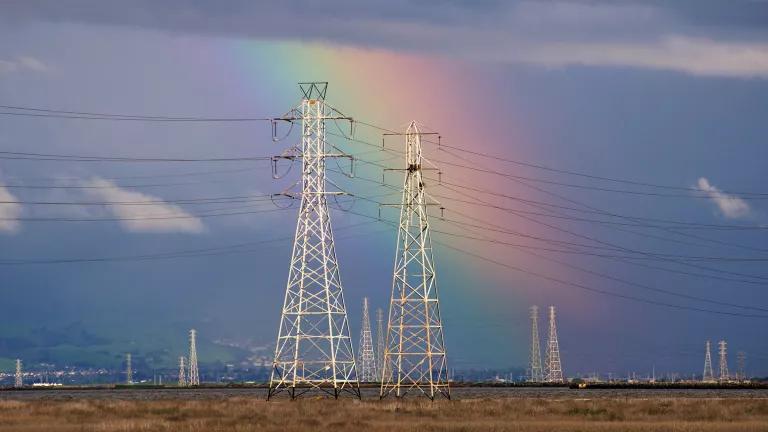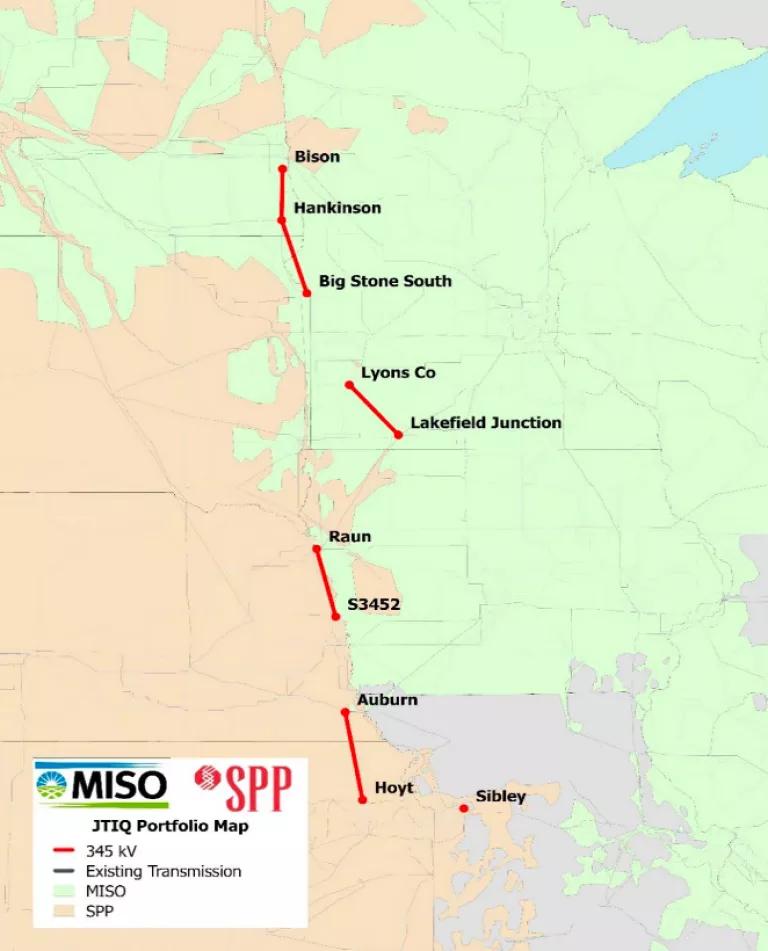A New Interconnection Queue Backlog Solution Gets Major DOE Backing
MISO and SPP’s unique interregional interconnection solution, JTIQ, needs to get across the finish line.

Power lines in the Palo Alto Baylands, California
This blog was coauthored by Kelly Tran, a summer intern with the Sustainable FERC Project.
A greener future requires a vast transformation in how we get our electricity. That means decarbonizing the electrical power grid to rely more on renewables and bringing on the transmission capacity to deliver the clean power these projects generate. Renewable project proposals are abundant, thanks to decreasing costs, increased policy focus from states, and funding from the 2022 Inflation Reduction Act.
But too many of these new generators still run headlong into interconnection challenges. Interconnection queues across the country are already immensely backlogged as renewables wait in line for their turn to be evaluated, which can take years. According to the Federal Energy Regulatory Commission (FERC), more than 2,000 gigawatts (GW) of generation and storage are stuck in queues—about as much as the existing electricity generation capacity across the country now.
Policymakers are taking action and beginning to drive innovative solutions within regional transmission organizations (RTOs) and independent system operators (ISOs) to break through these queue logjams and bring projects to life. This is a tremendous step forward and a credit to leaders at FERC, the RTOs, and ISOs. However, one tricky issue remains unresolved: how to break through holdups for projects that sit near the borders of RTOs and ISOs, called “seams,” where cost and delays caused by parallel queue processes on both sides of the seam too often force projects to die on the vine. Midcontinent Independent System Operator (MISO) and Southwest Power Pool (SPP) have a unique proposed solution, called a Joint Targeted Interconnection Queue (JTIQ). Last week, the U.S. Department of Energy (DOE) announced significant funding to support the first set of JTIQ transmission upgrades in several clean energy–dense states.
The complexity of studying projects near seams
Proposed new electricity generators must secure a spot in the interconnection queue to be studied before they can be built and connected to the grid. These studies ensure that the generators will not create problems for the rest of the system when they connect to the electrical power grid. FERC recently announced reforms to tackle interconnection queue backlogs. Its Order 2023 prioritizes projects in queues based on their likelihood to succeed and requires projects to be studied in clusters. While these reforms are an improvement for processing the regional queues, we want to highlight an issue that remains: projects bogged down at the borders, or so-called “seams,” of regions where clean energy has the potential to bring multiple benefits to several areas.
When a proposed generator is located near another region along a seam, one study is not enough. For these projects with cross-region impacts, the interconnection process requires an affected system studies (AFS) in addition to the host study to make sure that the new generator does not negatively affect neighboring grids. Clean energy developers wait to see if the AFS identifies any expensive upgrades they must pay for to maintain reliability before deciding whether they want to proceed with building their projects. This time-consuming and uncertain AFS process further traps renewables in queues with delays and high costs that cause some projects to drop altogether.
First, developers face double study costs for projects along the seams because they have to pay for two studies instead of one. Second, grid operators—who are oftentimes RTOs—do not give developers a clear timeline for when each AFS will be completed, and the AFS timelines are often not aligned with the host interconnection study timelines. This uncertain timing is especially problematic because once the host grid operator completes its interconnection study, a developer is forced to decide whether to continue the project, even though the remaining AFS by the neighboring grid operator may later reveal additional upgrade costs. This cost uncertainty may cause projects to withdraw when the first AFS wraps up, as upgrades can sometimes cost millions of dollars. If the developer withdraws after it has signed an interconnection agreement with the host system, penalties may be incurred, creating further risk for developers. Third, AFS upgrades are usually assigned to individual or just a few generators, rather than large groups of new projects, preventing a more efficient, fair, and sensible distribution of costs.
How JTIQ enables clean energy at seams
To pursue clean energy generation projects along seams, developers need more certainty about the cost and timelines than queues currently provide. And the AFS process should allow a large enough pool of developers to participate so that any required upgrade costs can be spread among them, making projects more likely to succeed. Two RTOs in the Midwest are currently proposing a creative solution to AFS backlogs to address these very problems.
MISO and SPP worked together for more than a year to conduct a Joint Targeted Interconnection Queue (JTIQ) study, evaluating large amounts of new generation in both regions along the seam to identify more cost-effective transmission solutions through greater economies of scale. This was a first-of-its-kind effort to conduct a joint generation interconnection study along their shared border, replacing the bifurcated AFS processes.
The study came up with a portfolio of seven transmission projects along the seam to bring benefits to both regions. Two projects have already been approved as regional upgrades, and the remaining portfolio of projects is expected to enable more than 28 GW of new generation along the MISO and SPP seam—enough to power almost 5 million homes with largely renewable, low-cost energy. One of these five projects has also recently been replaced with a lower-cost solution.

Figure 1. From the JTIQ Update, a presentation made to SPP’s Markets and Operations Policy Committee on October 17, 2023
SPP Markets and Operations Policy Committee
In addition to the benefit of adding this new generation, the portfolio would boost reliability, enhance resilience, and increase interregional transfer capacity for both regions, which is critical as extreme weather continues to threaten power outages across the nation. By reducing two AFS to a single study, the collaboration will also provide more cost and time certainty. Developers are expected to save on costs because of the economies of scale of the JTIQ, and they won’t have to wait for a second AFS study to be completed.
Next steps for JTIQ
Formal tariff changes needed to implement the JTIQ process, which we believe will support new clean energy generation, must first be approved by FERC. MISO and SPP are finalizing their proposal to send to the commission, yet JTIQ stakeholders still have concerns. Discussions center on the portfolio’s cost allocation and a recent increase in the estimate of overall cost. Due to a variety of reasons, the MISO and SPP cost estimate increased from $1.1 billion to $1.8 billion. Other issues raised relate to which generators will have to pay for the JTIQ projects, and whether the costs will change again after developers sign on the dotted line to pay their share. The recent DOE funding award, which will cover about 25 percent of the costs of these projects, should help interconnecting generators and utilities get more comfortable with the costs they will pay for these upgrades.
JTIQ is still a novel concept with some kinks to be worked out. But as it moves from proposal to reality, this solution to AFS challenges is worthy of DOE support. Innovation takes work, time, experimentation, and some risk. Considering the number of projects and investments that suffer in the AFS backlog, developers and grid operators should push to finalize the details of the JTIQ solution soon. These projects are needed to provide greater certainty, improve cohesive coordination, and bring more clean generation projects online.
Since JTIQ first began in 2020, the RTOs have made tremendous strides in rethinking AFS to address interregional issues. But at recent MISO and SPP stakeholder meetings, little progress was shown in moving the proposal forward. Time is of the essence. What is at risk if the JTIQ projects and this new process do not get realized is a loss of all of the portfolio’s benefits, including new reliable clean energy resources, savings to ratepayers, and improved stability. Moreover, new generation projects would remain waiting in queues again for uncertain AFS results, essentially starting the process over.
The DOE’s endorsement of the proposal is an exciting boost for increasing transmission and interregional capacity in the Midwest and improves the likelihood of JTIQ becoming a case study and guide for interregional expansion in other places along seams. If MISO, SPP, and other stakeholders can move forward with a general consensus of support soon, the portfolio’s success would not only advance the clean energy transition but could pave the way for other regions to develop similar innovative AFS alternatives to get renewables up and running along their seams.



